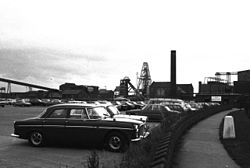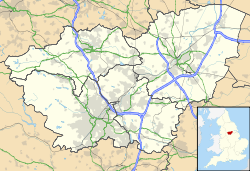- Markham Main Colliery
-
Markham Main Colliery 
Markham Main Colliery in August 1980Location Location in South Yorkshire 53.5374°N 1.07286°W / 53.5374°N 1.07286°WCoordinates: 53.5374°N 1.07286°W / 53.5374°N 1.07286°W
Location Armthorpe, DN3 2BP Unitary authority Doncaster, South Yorkshire Country England Production Products Coal History Opened 1916 Closed 1996 Markham Main Colliery was a coal mine in Armthorpe, on the eastern edge of Doncaster. It could be seen, and was a landmark, from the nearby M18. 87 miners were killed at the pit.
Contents
History
It was sunk on 6 May 1916 and work continued until 24 August 1916 when work stopped because of the war.[1] Work continued on 21 May 1922. Coal was first recovered on 5 May 1924. The site cost around £1 million pounds and a model village for the pit (Armthorpe) was built.
For many years it was used as a training pit for the local area, with a training tunnel. In the 1950s it had around 2,700 workers. A domestic fuel processing plant was built in 1966.
In the mid-1980s the pit had around 1,500 employees. When the 1980s miners' strike finished in 1985, Markham Main was the last Yorkshire pit to return to work, three days later.
On its initial closure in 1992 it had around 730 workers.
Closure
It closed in 1996 when it had 50 million tonnes of coal reserves, enough for around fifty years. The site is now a housing estate, next to Sandall Beat Wood.
Ownership
It was first run as Markham Main Colliery Ltd.
Doncaster Amalgamated Collieries
It was taken over by Doncaster Amalgamated Collieries Ltd in February 1937, based at The Lodge on South Parade in Doncaster. This company also owned Yorkshire Main Colliery at Edlington. The Chairman of this company was William Humble, whose son was Bill Humble the aviator and grand-daughter is Kate Humble. William Humble was a mining engineer who had overseen the construction of the pit.
National Coal Board
The British coal industry was nationalised in July 1946.
British Coal
The British coal industry was privatised in 1987 and ownership came under British Coal. In April 1992 there was a union dispute over the use of private contractors to develop new coalfaces at the pit. This development work would have been in the miners' long-term interests, but the unions claimed it was privatisation by the back-door. British Coal argued that outside contractors would carry out the work much quicker.
Michael Heseltine announced closure the pit in October 1992, as it was thought not to be economically viable; production stopped soon afterwards. After the announcement, local women set up a camp at the site to protest about its closure; this was the first of its kind. Another camp was set up at Houghton Main Colliery as part of the Women Against Pit Closures Campaign. Later in 1992 Michael Heseltine was considering saving the pit, along with one at Betws in Wales. The protests were often accompanied by the colliery band.
Coal Investments
It was bought by Malcolm Edwards' (former Commercial Director of British Coal) Coal Investments, which owned six pits, in May 1994. Coal Investments went into administration in February 1996. A buyer was looked for the pit but none found and on 28 June 1996 ownership was handed the Coal Authority by the liquidators. If no buyer was found, the only option for the Coal Authority was to sell off the mine's equipment at auction. Three of Coal Investments' pits had found buyers - Cwmgwili near Swansea, Silverdale, Staffordshire, and Annesley Bentinck Colliery. A buyer had earlier been found for these last two together with Markham Main which was financially backed by PhilDrew Ventures, but had lost out to management buy-outs which only bought the other two, and not all three. Most of the UK's pits at the time were owned by RJB Mining.
Markham Main was a less attractive prospect than other mines because it needed investment of around £8 million to improve a face gap in the coal seam. Had that investment been found, it would have had firm contracts from National Power and Eastern Group. By September 1996 the Coal Authority could not find a buyer and decided to close the pit.
Many pits closed in the 1990s because North Sea natural gas was a cheaper option than coal, and relatively plentiful. Now that North Sea gas is beginning to run out, due to heavy usage in producing 40% of the UK's electricity, gas is much more expensive for consumers, and coal for electricity generation is now once again economically viable.
Production
There were two shafts, both 5.18 metres in diameter. No.1 was 865 metres deep and No.2 was 683 metres deep. In the 1950s it produced 14,000 tonnes of coal a week.
In the mid-1980s it was producing around 18,000 tonnes of coal a week, with most going to local power stations along the Aire and Trent. Before the miners' strike of 1984 it was producing 24,000 tonnes a week.[2] It had three coal faces, with two coal cutting machines per face.
Production was restarted in autumn 1994 after the pit had closed in 1992.
Brass band
The brass band, also based in Armthorpe, is still in operation - the last vestige of the pit. However the brass band is more widely well-known than the pit. It was formed in 1924. It was named Markham Main Colliery Band in 1945.
The Musical Director is Robert Woffinden.
See also
- Markham Colliery at Staveley near Chesterfield
References
External links
Video clips
- Colliery band at Scarborough Barracks in Doncaster
Categories:- Coal mines in Doncaster
- Underground mines in England
- 1916 establishments in England
- 1996 disestablishments
Wikimedia Foundation. 2010.

